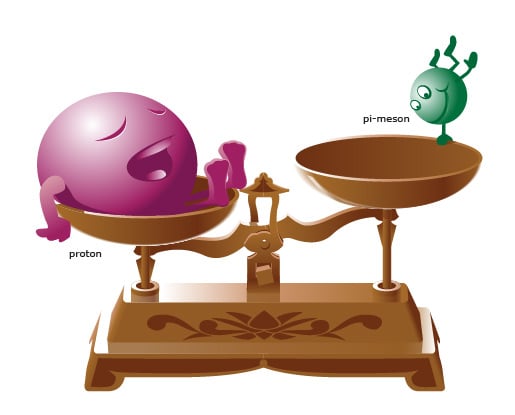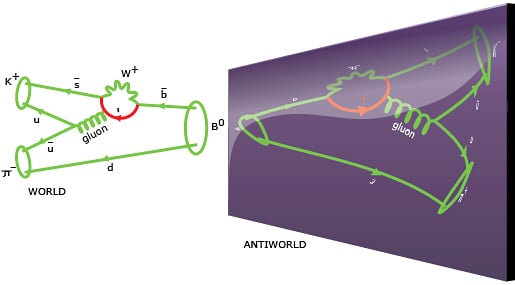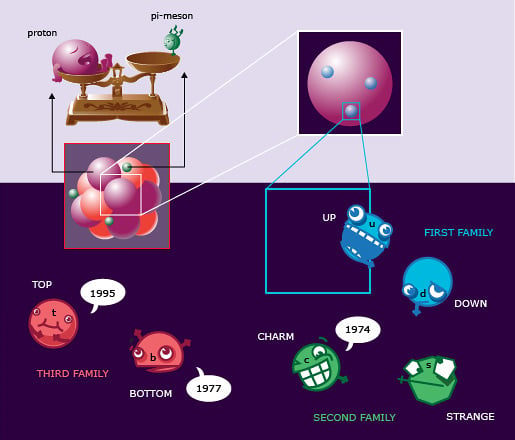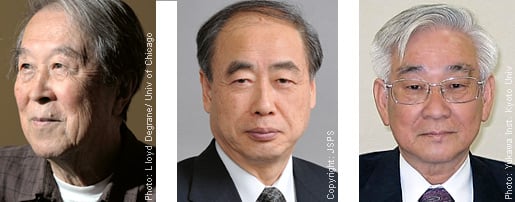Illustrated Presentation
Contents
A passion for symmetry
We are all children of broken symmetry
Laws of symmetry govern the micro world
Quarks – the smallest building blocks of matter
Yoichiro Nambu, Makoto Kobayashi and Toshihide Maskawa
Further reading
Credits
The Royal Swedish Academy of Sciences has decided to award the Nobel Prize in Physics for 2008 to Yoichiro Nambu “for the discovery of the mechanism of spontaneous broken symmetry in subatomic physics” and to Makoto Kobayashi and Toshihide Maskawa “for the discovery of the origin of the broken symmetry which predicts the existence of at least three families of quarks in nature”.
A Passion for Symmetry
The fact that our world does not behave perfectly symmetrically is due to deviations at the microscopic level. Why is there something instead of nothing? Why are there so many different elementary particles? The answers are hidden in nature’s laws of symmetry. Or rather, in two types of broken symmetries: those that existed in our universe from the very beginning and those that have spontaneously lost their original symmetry somewhere along the way.

The pi-meson, the messenger of the strong force that keeps the atomic nucleus together, has an unusual property. It is much lighter than the proton. Why is this? Nambu found a symmetry here that was imperfect, hidden by a spontaneous broken symmetry. This explains the pi-meson’s low mass. Nambu’s theory also claimed that the pi-meson was a composite particle – today we know that it is composed of quarks.
We are all children of broken symmetry
Broken symmetry lies behind the origins of the cosmos in the Big Bang some
14 billion years ago. If equal amounts of matter and antimatter were created, they ought to have annihilated each other, leaving only radiation. But this did not happen, there was a tiny deviation of one extra particle of matter for every 10 billion antimatter particles – enough to make our world survive. How this broken symmetry happened is still a major mystery.
Spontaneous broken symmetry
Nambu’s surprising explanation to the riddle of pi-meson’s low mass pointed to spontaneous broken symmetry. Symmetry can be broken spontaneously if a physical system drops into a new state with lower energy, hence, this occurs at the price of a symmetry violation. Although the new state does not exhibit the symmetry, Nambu discovered that the symmetry survives, albeit in a hidden form. Hence his theory permits the use of the symmetry’s mathematical properties, enabling calculations which can be compared with experiments.
Different variants of Nambu’s spontaneous broken symmetry are currently used in several areas of physics. Particle physicists believe that spontaneous broken symmetry destroyed the original symmetry and assigned particles different masses in the universe’s earliest moments. How this occurred, they hope to be able to explore at the world’s largest particle accelerator, the new LHC at CERN in Geneva.
In 1960, Nambu was the first to introduce spontaneous broken symmetry into elementary particle physics. To begin with, he worked on theoretical calculations of another remarkable phenomenon in physics, superconductivity, when electric currents suddenly flow without any resistance. Spontaneous broken symmetry that described superconductivity was later translated by Nambu into the world of elementary particles, where it became one of the corner stones of the most successful theory in particle physics – the Standard Model.

Laws of symmetry govern the micro world
Symmetries play a decisive role in the mathematical description of the world. The basic theory for elementary particles describes three principles of mirror symmetry: the usual mirror symmetry where there should not be any difference between left and right; charge symmetry, where particles behave like antiparticles, which have exactly the same properties but the opposite charge; and time symmetry, where physical events at the micro level should be equally independent whether they occur forwards or backwards in time.
Transformation acts in the quantum world
In order to explain the mirror and charge symmetry violation that was observed by experiments, Kobayashi and Maskawa needed a third family of quarks. Only then could the quarks accomplish the act of transformation which is only possible in a quantum world. There they can switch identities time and time again, becoming another quark or an antiquark. For example, when a particle, a B-meson, decays, one of its building blocks, the bottom (b) quark can, for a brief instant, transform into one of the three possible shapes and become an up (u) quark, charm (c) quark or a top (t) quark. This process differs from what is expected for the bottom quark’s antiparticle, the anti-bottom quark, and thus the symmetry is broken.

Kobayashi and Maskawa’s theory predicted that the decay of B-meson particles was different in the world and in the antiworld.
Physicists confirm the theory of symmetry violation
As recently as 2001, the two particle detectors BaBar at Stanford, USA and Belle at Tsukuba, Japan, both detected broken symmetries independently of each other. The results were exactly as Kobayashi and Maskawa had predicted almost three decades earlier.
Quarks – the smallest building blocks of matter
When Kobayashi and Maskawa presented their theory of symmetry violation only three quarks were known, but their model needed at least six. This was a bold concept, and these speculative new quarks did appear as predicted in later experiments: charm (1974), bottom (1977) and the top quark (1995). These quarks are currently a part of the Standard Model of particle physics that unifies all the smallest building blocks of matter and three of nature’s four forces in one single theory.

The broken symmetries described by Kobayashi and Maskawa seem to have existed in nature since the very beginning. This same symmetry violation, although on a much bigger scale, is responsible for the existence of our universe. It came as a complete surprise when it first appeared in particle physics experiments in 1964, and it is only very recently that scientists have been able to fully confirm the explanations that Kobayashi and Maskawa made in 1972. The hypothetical new quarks that were needed for the theory have also only recently appeared in physics experiments.

Yoichiro Nambu
Yoichiro Nambu,
US citizen. Born 1921 in
Tokyo, Japan. D.Sc. 1952
at University of Tokyo,
Japan. Harry Pratt Judson Distinguished Service
Professor Emeritus at
Enrico Fermi Institute, University of Chicago,
IL, USA.
Makoto Kobayashi
Makoto Kobayashi,
Japanese citizen. Born 1944
in Nagoya, Japan. Ph.D.
1972 at Nagoya University, Japan. Professor Emeritus
at High Energy Accelerator Research Organization
(KEK), Tsukuba, Japan.
Toshihide Maskawa
Toshihide Maskawa,
Japanese citizen. Born 1940 in Nagoya, Japan. Ph.D. 1967 at Nagoya University, Japan. Professor Emeritus at Yukawa Institute for Theoretical Physics (YITP), Kyoto University, and Professor at Kyoto Sangyo University, Japan.
Further reading |
| More information about the Nobel Prize in Physics for 2008 can be found at: www.kva.se, http://www.nobelprize.org, www.nobelmuseum.se |
| In Search of Antimatter by Sarah Graham, Scientific American, August 2001 |
| The Asymmetry between Matter and Antimatter by Helen Quinn and Michael Witherell, Scientific American, October 1998 |
| Profile: Yoichiro Nambu by Madhusree Mukerjee, Scientific American, February 1995 |
| Links: |
| The Nobel Prize in Physics 1957, 1969, 1976, 1980, 1990 and 1999: https://www.nobelprize.org/prizes/lists/all-nobel-prizes-in-physics/ |
| CERN: http://public.web.cern.ch/Public/ |
| The particle adventure: http://particleadventure.org/ |
| SLAC: http://www2.slac.stanford.edu/vvc/ |
Credits and references for the 2008 Nobel Poster for Physics
Editors: Lars Bergström, Secretary, the Nobel Committee for Physics, the Royal Swedish Academy of Sciences, Lars Brink and Gunnar Ingelman, Members of the Royal Swedish Academy of Sciences, Joanna Rose, Joanna Rose Vet, Johan Rathsman, Uppsala University, Annika Moberg and Andrea Westerdahl, the Royal Swedish Academy of Sciences.
Layout and illustrations by Typoform
Printed by AlfaPrint AB, Stockholm, 2008
Copyright © 2008 The Royal Swedish Academy of Sciences
Box 50005, SE-104 05 Stockholm, Sweden
Phone:+46 8 673 95 00, fax: +46 8 15 56 70
e-mail: info@kva.se, www.kva.se
Posters may be ordered free of charge by phone, fax or e-mail.
Web adapted version: Nobelprize.org
Nobel Poster from the Nobel Committee for Physics, web adapted by Nobel Web
Nobel Prizes and laureates
Six prizes were awarded for achievements that have conferred the greatest benefit to humankind. The 12 laureates' work and discoveries range from proteins' structures and machine learning to fighting for a world free of nuclear weapons.
See them all presented here.
